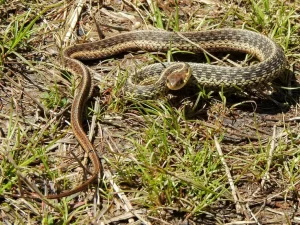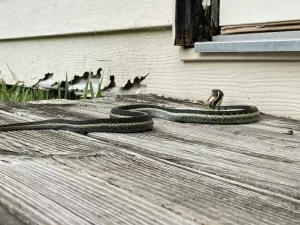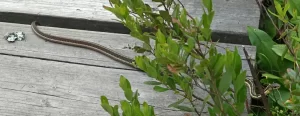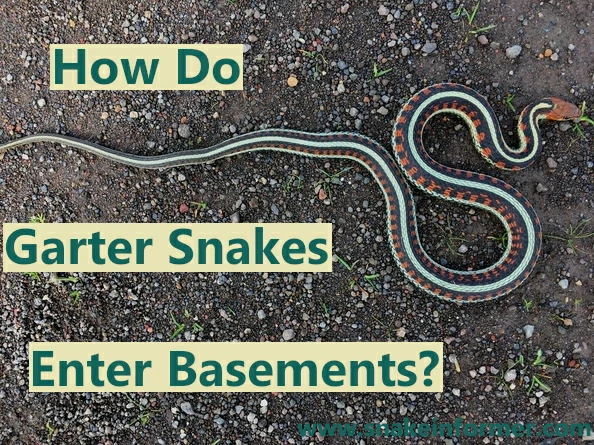Garter snakes are medium-sized snakes easily recognizable by the distinctive stripes running lengthwise along their scales. They are usually found in forest areas but often wander into people’s backyards and basements.
Garter snakes can not dig, so the only way they can enter basements is through open spaces. This could be through cracks or openings in the foundation, gaps around doors or windows, vents, pipes, or even rodent burrows.
When garter snakes enter your basement, they are usually in search of food, shelter, or warmth.
For example, if you have rodents in your basement, garter snakes searching for food may be attracted to the area.
Garter Snakes Enter Basements Through Small Openings
As mentioned earlier, garter snakes don’t dig holes.

For this reason, the only way they can enter your basement is through open spaces.
This could be via:
1. Cracks or Openings in the Foundation
Garter snakes are very flexible and can squeeze through smaller holes than most people think.
Juvenile garter snakes can squeeze through holes as small as 1/4 inch, and adults can squeeze through an opening of 1/2 inch.
Small cracks in the foundation of your basement can provide an entryway for garter snakes.
2. Gaps Around Doors
Garter snakes can also enter your basement through gaps at the bottom or sides of your doors.

Damage in wooden thresholds, or even loose or missing weather stripping under the door – can leave a space large enough for a garter snake to squeeze through.
Sometimes, garter snakes can enter your basement through open doors or windows.
If a door is left open for even just a few minutes, a garter snake can sneak in unseen.
3. Rodent Burrows
Rodents often dig holes near or under the foundation, and these tunnels may be deep enough to connect with basement walls.
If a rodent burrow opens into your basement, a garter snake can easily slither in.
In simple words, rodent holes can provide ready-made tunnels that lead into your basement.
4. Damaged or Poorly Sealed Vents
Poorly sealed basement vents can provide an entryway for garter snakes.
For example, the area where the vent pipe passes through the wall might have gaps that weren’t properly sealed.
Also, if a vent has no screen, or the screen is damaged, a snake can slither right in.
5. Openings Around Plumbing, or Electrical Conduits
Gaps around plumbing, or electrical conduits may not be properly sealed, and this can provide an easy entry point for garter snakes.
Garter Snakes Can Enter Your House, Then Make Their Way to the Basement
Although garter snakes can enter your basement directly, sometimes – they can sneak into your house.
Although garter snakes can climb walls, they are typically not very arboreal and will spend most of their time on the ground.
For this reason, most garter snakes that come into your house will enter on the ground floor, rather than up the wall.
This could be:
- Gaps under doors
- Cracks or openings in walls
- Pet doors
- Pipes
- Vents
- Any other space that leads to your house
If a window or door is left even just a few inches open, an adult garter snake can squeeze through.

In addition, garter snakes could hide in large plants or objects outdoors, and then find themselves inside, when these are transferred indoors.
Once inside your house, they can move around and make their way to the basement.
6 Tips to Prevent Garter Snakes From Entering Your Basement
If you want to stop garter snakes from coming into your basement, you have to make the area around your house less attractive to them.
Here are a number of things you can do to keep garter snakes from entering your house.
1. Keep Mice and Other Small Animals Away From Your House
One of the easiest ways of keeping snakes away is to get rid of the “snake food” (prey animals) you have in or around your house.
You can do this by getting rid of trash piles, or anything that may attract rodents or insects.
Ensure that food scraps are disposed of properly, as rats and mice are attracted to places where they can find food.
Also, avoid leaving uneaten pet food outdoors, and consider storing any bird seed in rodent-proof containers.
In essence, make sure there is nothing in or around your house that can attract mice, or other animals that garter snakes prey on.
2. Seal All Entryways
Block off as many possible entryways to your house as possible, to reduce the chance of a garter snake slithering inside.
Screen all outside vents, seal cracks and holes around the foundation, and make sure doors and windows fit tightly.
In addition, seal off access to basements and crawlspaces.
Garter snakes can squeeze through spaces only a few inches wide, so even tiny holes should be blocked off.
3. Keep Your Grass Short
Tall grass provides the perfect cover for snakes to hide in. It also attracts mice, and other small animals that garter snakes prey on.
Keep your grass, and other vegetation around the house short. This will discourage garter snakes from coming into your yard, and into your home.
It will also make it easy to spot the snakes that do end up in your yard so you can get rid of them.
4. Clear Dead Leaves and Other Dead Vegetation
Snakes love to hide under dead logs and leaf litter on the ground.
Getting rid of these will keep garter snakes away because they will have fewer places to hide.
5. Keep Firewood, Compost Piles, and Other Types of Debris Away From Your Home
Snakes love to hide in well-covered areas outside. Compost piles or stacks of firewood and lumber are the perfect places for garter snakes to hide.
If these are kept close to the house, garter snakes can easily make their way inside.
Store firewood, lumber, and other piles of debris away from your home.
6. Be Vigilant During the Warm Seasons of the Year
Snakes and other reptiles are most active when the temperatures are warm.
Be alert during this time of the year and watch for any garter snakes that may end up in your yard, so they do not get inside the basement.
Conclusion
Garter snakes are some of the most common snakes in North America, and these snakes often enter people’s homes and basements.
These can squeeze through small openings and end up inside your basement.
That said, it’s important to note that snakes will never come into your house with the intention of causing harm.
Instead, they often end up inside the basement in search of food or shelter.
Sources:
Virginia Cooperative Extension. Snake in the Basement? (PDF)
Hi, my name is Ezra Mushala, i have been interested animals all my life. I am the main author and editor here at snakeinformer.com.

